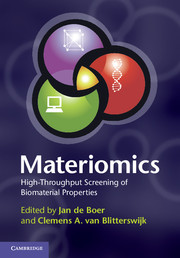Book contents
- Frontmatter
- Contents
- List of contributors
- Preface
- Chapter 1 Introducing materiomics
- Chapter 2 Physico-chemical material properties and analysis techniques relevant in high-throughput biomaterials research
- Chapter 3 Materiomics using synthetic materials: metals, cements, covalent polymers and supramolecular systems
- Chapter 4 Microfabrication techniques in materiomics
- Chapter 5 Bioassay development
- Chapter 6 High-content imaging
- Chapter 7 Computational analysis of high-throughput material screens
- Chapter 8 Upscaling of high-throughput material platforms in two and three dimensions
- Chapter 9 Development of materials for regenerative medicine: from clinical need to clinical application
- Chapter 10 Non-biomedical applications of materiomics
- Chapter 11 Beyond bed and bench
- Index
- References
Chapter 5 - Bioassay development
Published online by Cambridge University Press: 05 April 2013
- Frontmatter
- Contents
- List of contributors
- Preface
- Chapter 1 Introducing materiomics
- Chapter 2 Physico-chemical material properties and analysis techniques relevant in high-throughput biomaterials research
- Chapter 3 Materiomics using synthetic materials: metals, cements, covalent polymers and supramolecular systems
- Chapter 4 Microfabrication techniques in materiomics
- Chapter 5 Bioassay development
- Chapter 6 High-content imaging
- Chapter 7 Computational analysis of high-throughput material screens
- Chapter 8 Upscaling of high-throughput material platforms in two and three dimensions
- Chapter 9 Development of materials for regenerative medicine: from clinical need to clinical application
- Chapter 10 Non-biomedical applications of materiomics
- Chapter 11 Beyond bed and bench
- Index
- References
Summary
Scope
Combinatorial chemistry and high-throughput synthesis of novel materials warrant a paradigm shift in current methods to analyse biological responses. This chapter will provide an overview on bioassay development and how novel assays amenable to high-throughput screening platforms can be adapted to more complex systems. Special emphasis will be devoted to the development of assays that can be used in platforms that closely mimic the in vivo complexity of tissues and organs. In that respect, assays that can cope with co-culture systems as well as 3D environments will be discussed. Moreover, modifications or development of new assays and techniques will be described as well as their respective advantages and disadvantages.
Basic principles of assay development
The ability to measure the speed of light changed the field of physics and the world. Chemical reactions led to the Big Bang and the creation of the Universe, but the ability to measure and control those reactions changed the face of the Earth. We can surely say that the need to see more, and in more detail, led to the development of technologies that made that possible and ultimately contributed to the advance of science and society.
- Type
- Chapter
- Information
- MateriomicsHigh-Throughput Screening of Biomaterial Properties, pp. 67 - 84Publisher: Cambridge University PressPrint publication year: 2013



